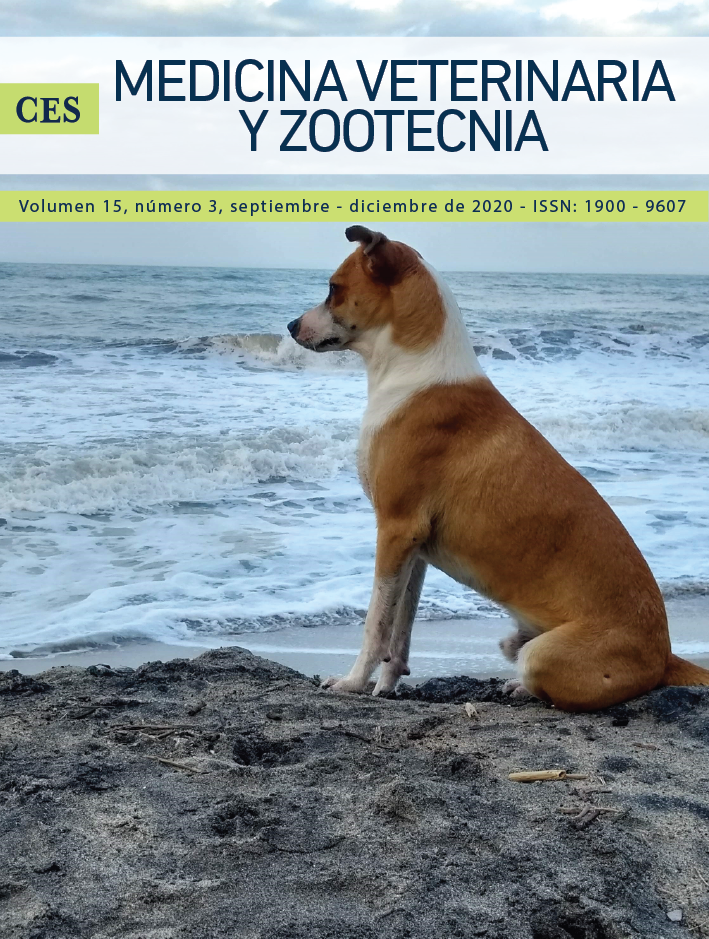Selected performance parameters in laying hens and broiler chickens receiving diets containing Colombian corn or corn imported from the United States
DOI:
https://doi.org/10.21615/cesmvz.15.3.1Keywords:
carcass yield, egg quality, fatty acid, mycotoxin, poultry production, proximal analysisAbstract
The present study evaluated possible differences in production performance and egg quality parameters in laying hens and broiler chickens fed diets formulated with corn produced in Colombia or corn imported from the United States. For the laying hen trial, eighty 24-week-old Hy-Line Brown hens were randomly distributed into two treatments, each with 40 individually caged birds. The diets contained 56.7% corn and were provided ad libitum for 20 weeks. For the broiler chicken trial, 352 male one-day-old Ross 308 AP chicks were randomly distributed into two dietary treatments, with 8 replicate pens of 22 birds each. The diets contained between 51.0 (starter) and 59.6% (finisher) corn and were provided ad libitum for 35 days. Data from the 20 experimental weeks from the laying hen trial showed a trend for higher egg weight (p = 0.06) in the hens fed the diet containing national corn (61.4 vs. 59.9 g), coupled with a slightly lower feed conversion rate (1.95 vs. 1.97). In regard to egg quality, yolk color showed higher values (p < 0.01) for the eggs from the hens fed national corn at weeks 4 and 12, but lower at week 20. Haugh units were significantly higher (p = 0.002) in the eggs from the birds fed national corn (106 vs. 102). The broiler chicken trial showed a significantly lower (p = 0.04) cumulative feed conversion rate for the chickens fed the diet containing national corn compared with those fed the imported corn (1.37 vs. 1.42). Carcass yield showed a significantly (p < 0.01) higher breast percentage in the chickens fed the imported corn (27.9% vs. 26.3%). The results of two trials showed some differences in production parameters in layers and broilers that favored the use of national corn compared with imported corn. More studies are needed to determine if these differences are seen in full production cycles (laying hens) and to investigate possible differences in complete diets for other domestic species.
Downloads
References
Agama-Acevedo E, Salinas-Moreno Y, Pacheco-Vargas G, Bello-Pérez LA. Características físicas y químicas de dos razas de maíz azul: morfología del almidón. Rev Mex De Cienc Agric 2011; 2 (3): 317-329.
Aguillón-Páez YJ, Romero LA, Diaz GJ. Effect of full-fat sunflower or flaxseed seeds dietary inclusion on performance, egg yolk fatty acid profile and egg quality in laying hens. Anim Nutr 2020; 6 (2): 179-184. https://doi.org/10.1016/j. aninu.2019.12.005
Allen NK, Mirocha CJ, Aakhus-Allen SA, Bitgood JJ, Weaver G, Bates F. Effect of dietary zearalenone on reproduction of chickens. Poult Sci 1981b; 60 (6): 1165-1174. https://doi.org/10.3382/ps.0601165
AOAC. Association of Official Analytical Chemists. Official Methods of Analyses. 18th Ed. Gaithers burg MD, USA. 2006
Arrué Tobar JA. Evaluación de un blend nutricional en la calidad del huevo de un sistema intensivo de gallinas de postura. Tesis de maestría, Facultad de Agronomía e Ingeniería Forestal, Pontificia Universidad Católica de Chile. Santiago-Chile, 2018. 28 p.
Café MB, Borges CA, Fritts CA, Waldroup PW. Avizyme improves performance of broilers fed corn-soybean meal-based diets. J Appl Poult Res 2002; 11 (1): 29-33, https://doi.org/10.1093/japr/11.1.29
Castaneda MP, Hirschler EM, Sams AR. Skin pigmentation evaluation in broilers fed natural and synthetic pigments. Poult Sci 2005; 84 (1): 143-147.
Christensen CM, Kaufmann HH. Deterioration of stored grains by fungi. Annu Rev Phytopathol 1965; 3 (1): 69-84.
Diaz GJ. Toxicología de la micotoxinas y sus efectos en avicultura comercial. Editorial Acribia. Zaragoza (España); 2020.
Dudusola IO. Comparative evaluation of internal and external qualities of eggs from quail and guinea fowl. Int. Res J Plant Sci 2010; 1 (5): 112-115.
Fedegan. Federación Nacional de Ganaderos. Estadísticas. [Internet] [Consultado 14 Jul 2020]. Disponible en: https://www.fedegan.org.co/estadisticas/consumo-0
Fenalce. Federación Nacional de Cultivadores de Cereales y Leguminosas. Comunicado de los agricultores nacionales de maíz. [Internet] [Consultado 14 Jul 2020]. Disponible en: https://www.fenalce.org/alfa/pg.php?pa=60
Fenavi. Federación Nacional de Avicultura de Colombia. Estadísticas. [Internet] [Consultado 14 Jul 2020]. Disponible en: https://fenavi.org/informacion-estadistica/
Folch J, Lees M, Stanley GS. A simple method for the isolation and purification of total lipids from animal tissues. J Biol Chem 1957; 226 (1): 497-507.
García DM, Colas MC, López WS, Pérez EO, Sánchez AP, et al. El peso corporal y su efecto sobre indicadores bioproductivos en gallinas White Leghorn L33. Rev. Med. Vet. Zoot 2016; 63 (3): 188-200.
Hamilton RMG, Thompson BK, Trenholm HL. Feed-intake, egg-production and shell quality of hens given diets that contained vomitoxin contaminated wheat. Poult Sci 1981a; 60 (7): 1666 (abstract).
Hamilton RMG, Thompson BK, Trenholm HL. The effect of vomitoxin contaminated wheat on the palatability of laying diets by white leghorn hens. Poult Sci 1981b; 60 (7): 1665-1666 (abstract).
Harwood JL. Environmental effects on plant lipid biochemistry. In: Harwood JL. Plant lipid biosynthesis: fundamentals and agricultural applications, 305. Cambridge University press. 1998
Haugh RR. The Haugh unit for measuring egg quality. United States egg and poultry magazine, 1937; 43: 522-555.
Karunajeewa H, Hughes RJ, McDonald MW, Shenstone FS 1984 A review of factors influencing pigmentation of egg yolks. Worlds Poult Sci J 1984; 40 (1): 52-65, https://doi.org/10.1079/WPS19840006
Manresa González A, Vicente I. El color en la industria de los alimentos. Ciudad de La Habana: Editorial Universitaria. 2007.
National Research Council. Nutrient requirements of poultry (9th rev.), Natl. Acad. Press, Washington, D.C 1994. DOI: 10.17226/2114.
Norma Técnica Colombiana. NTC 6027. Determinación de toxinas T-2 y HT-2 en granos de cereal mediante limpieza por inmunoafinidad y cromatografía líquida con detección de fluorescencia. Editada por el Instituto Colombiano de Normas
Técnicas y Certificación (Icontec). Apartado 14237. Bogotá, D.C. Editada 2013- 11-27.
Norma Técnica Colombiana. NTC 5961. Determinación de deoxinivalenol (DON) en harina de trigo blanca, harina de trigo integral y salvado de trigo mediante cromatografía líquida de alta eficiencia / extracción de fase sólida. Editada por
el Instituto Colombiano de Normas Técnicas y Certificación (Icontec). Apartado 14237. Bogotá, D.C. Editada 2012-12-21.
Norma Técnica Colombiana. NTC 5472. Determinación de ocratoxina A en cereales y sus derivados por cromatografía líquida de alta eficiencia, HPLC. Editada por el Instituto Colombiano de Normas Técnicas y Certificación (Icontec). Apartado 14237. Bogotá, D.C. Editada 2007-03-28.
Norma Técnica Colombiana. NTC 4881. Método de análisis de Zearalenona de ocurrencia natural. Editada por el Instituto Colombiano de Normas Técnicas y Certificación (Icontec). Apartado 14237. Bogotá, D.C.
Norma Técnica Colombiana. NTC 1232. Método de análisis de aflatoxinas de ocurrencia natural (B1, B2, G1 y G2). Editada por el Instituto Colombiano de Normas Técnicas y Certificación (Icontec). Apartado 14237. Bogotá, D.C. Primera actualización 2001-09-11.
Martos P, Thompson W, Diaz G. Multiresidue mycotoxin analysis in wheat, barley, oats, rye and maize grain by high-performance liquid chromatography-tandem mass spectrometry. World Mycotoxin J 2010; 3 (3): 205-223. https://doi.org/10.3920/WMJ2010.1212
Philip T, Weber CW, Berry JW. Utilization of lutein and lutein‐fatty acid esters by laying hens. J Food Sci 1976; 41 (1): 23-25, https://doi.org/10.1111/j.1365-2621.1976.tb01092.x
Scheideler SE, Rice D, Smith B, Dana G, Sauber T. Evaluation of nutritional equivalency of corn grain from DAS-Ø15Ø7-1 (Herculex* I) in the diets of laying hens. J Appl Poult Res 2008; 17 (3): 383-389, https://doi.org/10.3382/japr.2007-00080
Simopoulos AP. Omega-6/omega-3 essential fatty acids: biological effects. World Rev Nutr Diet 2009; 99 (1): 1-16.
Statistix 9. User’s Manual, Analytical software. Tallahassee, Florida. 2008.
USDA-GIPSA. United States Standards for Corn. USDA Grain Inspection, Packers and Stockyards Administration (GIPSA). 1996. [Internet] [Retrieved 16 Dec 2019]. From http://www.gipsa.usda.gov/fgis/standards/810corn.pdf.
Valencak TG, Gamsjäger L, Ohrnberger S, Culbert NJ, Ruf T. Healthy n-6/n-3 fatty acid composition from five European game meat species remains after cooking. BMC Res Notes 2015; 8 (1): 273, https://doi.org/10.1186/s13104-015-1254-1
Downloads
Published
How to Cite
Issue
Section
License
Copyright (c) 2020 CES Medicina Veterinaria y Zootecnia

This work is licensed under a Creative Commons Attribution-ShareAlike 4.0 International License.
| Article metrics | |
|---|---|
| Abstract views | |
| Galley vies | |
| PDF Views | |
| HTML views | |
| Other views | |



